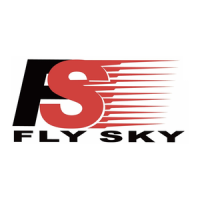Version 2 10 1 July 2021
Appendix
Discussion on Weather Helm, Rudder Use and Starting a Race
Weather Helm
These musings are meant to provide some background to the set-up of the DF65 winch and rudder
using the FlySky system.
When racing, ideally, in steady-state conditions, we want the boat to track in a straight line
particularly to windward with nil or only slight weather helm. If there is too much the boat will
round-up and go into irons.
There are several measures theoretically possible to achieve balance:
1. Constant and skilful rudder movement will provide straight line tracking however rudder
movement is slow as the rudder when used provides a greater projected surface area in the
direction of travel. It acts a bit like a brake.
2. Mast rake by adjusting deck plate (the movement fore’n’aft can swing the top of the mast
through 100mm), forestay and backstay tension. By these adjustments, the sail’s
combined Centre of Effort (CE) can be moved fore and aft relative to the foil’s Centre of
Lateral Resistance (CLR). By this we are essentially controlling the couple between these
two forces. There is plenty of reading on the internet and elsewhere about this and won’t
be repeated here. Generally a small amount of weather helm is safer and it is desirable to
provide a bit of feedback to the helmsman otherwise the steering will feel dead. The latter
does not apply to RC yachting.
There is no known easy way of setting up optimal mast rake except by trial-and-error. The
recommended measurement from a reference point on the upper mast to a point on the
deck is about all there is. This method is a guide only and not very accurate. See Soch
Sails DF65 Rig Tuning Guide.
3. Changing the CLR by lifting the centreboard/keel (impossible with DF65)
4. Reduce the power of mainsail by easing main sheet (more of this later), flattening foot or
ease boom vang to soften leech (i.e.. spill more wind from back of sail)
5. Reef main
6. Increase power of jib by moving its CE forward and thus moving the entire rig CE forward.
In an RC yacht a bit of weather helm is desirable, not for feel, but for another reason.
When moving through the water the foils provide lift. This is analogous to the wing (foil) on
an aircraft, particularly a glider. The downward gravitational force of the glider is balanced
or counter-acted by the lift provided by the wing. One approach with DF65s might be to
use the Trim tab referred to earlier and this might be a quick fix on one tack however it may
have to be removed or re-applied on the other tack. There is no known way that an RC
yacht can be provided with an offset rudder to provide the required minimal amount of
rudder on both tacks.
The only way an RC yacht can move in a straight is by the accurate alignment of CLR and CE.
However any particular setting is only good for a particular set of wind and wave conditions. And
may only be good for a particular tack.
In a wind gust these balanced forces become out-of-balance. The wind force on the sails
increases with the square of the wind velocity but the counteracting force from velocity of water
over the foils does not increase because in the instant the gust hits the boat speed has not
increased and the boat rounds up.
The second impact of a gust is to heel the boat. The underwater shape of the hull changes from
one that is symmetrical (when mast is vertical) to one where the line of least resistance is for the
hull to move to weather. So to counter the boat rounding-up, rudder is used to force the bow down.
But as the hull heals the rudder has less effective area in the direction of travel and more and more
rudder has to be used. Any rudder movement slows the boat because of Newtons First law and
the greater the rudder movement the greater the impact on speed. In short, any rudder movement
is slow.

